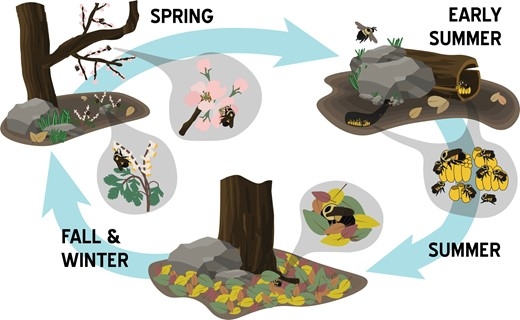- Author: Kathy Keatley Garvey

Yes, says UC Davis alumnus and research ecologist John Mola and his colleagues in a newly published article, "The Importance of Forests in Bumble Bee Biology and Conservation," the cover story in the current edition of the journal Bioscience.
"Forests are often critical bumble bee habitat," wrote Mola, a U.S. Geological Survey Mendenhall Postdoctoral Fellow based at the Fort Collins Science Center, Colorado, and a former member of the Neal Williams laboratory, UC Davis Department of Entomology and Nematology. He authored the research article with colleagues Jeremy Hemberger, a postdoctoral researcher in the Williams lab; Jade Kochanski of the University of Wisconsin, Madison; Leif Richardson of the Xerces Society for Invertebrate Conservation; and UC Davis alumnus Ian Pearse of the Fort Collins Science Center.
The cover image by Diego Delso shows a Bombus terrestris, a buff-tailed bumble bee that is one of the most numerous bumble bee species in Europe. He captured the image on a pink mulla mulla, Ptilotus exaltatus, in Estonia.
The abstract:
"Declines of many bumble bee species have raised concerns because of their importance as pollinators and potential harbingers of declines among other insect taxa. At present, bumble bee conservation is predominantly focused on midsummer flower restoration in open habitats. However, a growing body of evidence suggests that forests may play an important role in bumble bee life history. Compared with open habitats, forests and woody edges provide food resources during phenologically distinct periods, are often preferred nesting and overwintering habitats, and can offer favorable abiotic conditions in a changing climate. Future research efforts are needed in order to anticipate how ongoing changes in forests, such as overbrowsing by deer, plant invasions, and shifting canopy demographics, affect the suitability of these habitats for bumble bees. Forested habitats are increasingly appreciated in the life cycles of many bumble bees, and they deserve greater attention from those who wish to understand bumble bee populations and aid in their conservation."

"Despite their lower numerical abundance, recent studies have shown that these phases of bumble bee life history are especially important in determining the trajectory of their populations (Crone and Williams 2016, Carvell et al. 2017)," they wrote. "Because forests in many regions contrast with open habitats in terms of their flowering phenology, structural features, and abiotic conditions, these habitats may be particularly relevant to the understudied portions of the bumble bee life cycle. When considering the bumble bee year more broadly to include early floral resources or nesting and overwintering habitat, the role of forests, forest edges, and other woody habitats becomes more central in our understanding of bumble bee biology."
They concluded: "We hope our perspective does not provide the idea that forests are required for bumble bees but instead that they offer a cost effective means to provide foraging, nesting, and overwintering habitats that are compatible with conservation goals of other organisms (Williams 2011, Bentrup et al. 2019) and may be overlooked in studies of bumble bee biology. A recurrent problem in bumble bee conservation is the lack of informed demographic models or an understanding of basic aspects of species biology (i.e., nesting and overwintering). Increasing our capacity to incorporate forests into these efforts is likely to produce rich data sets that better inform conservation efforts and lead to the development of useful demographic models."
Active in bumble bee research, Mola is an invited participant on both the Western Bumble Bee Species Status Assessment Expert Group and the Native Bee Monitoring Research Coordination Network, and is also an organizing member (since 2020) of BOMBUSS: Building Our Methods by Using Sound Science.
"The BOMBUSS mission," according to its website, "is to bring researchers working on bumble bee biology together to discuss the methodologies currently used to investigate these important pollinators. As domestication of bumble bees has expanded worldwide, so has research on this group of bees as model organisms for study, as crop pollinators, and as conservation targets. The growth of this field of study has been rapid, prompting the organizers to convene this meeting to discuss the need and potential for standardization of methods."
BOMBUSS goals are five-fold:
- to identify the areas where common methodology already exists,
- identify areas where best practices can be suggested,
- identify gaps in the literature regarding methodology,
- share knowledge and build networks for advancing our science,
- formulate plans to address the gaps through peer-reviewed publication.
Mola received his doctorate in ecology in 2019 from UC Davis. He presented his exit seminar on "Bumble Bee Movement Ecology and Response to Wildfire."
At UC Davis, Mola was a Professors for the Future Fellow, receiving a year of professional development and pedagogical training. His honors also include a 2013-2018 National Science Foundation Graduate Research Fellowship of $133,500 and a 2014-2016 UC Davis Graduate Group in Ecology Fellowship of $43,000. He won the graduate student research poster competition at the 2018 UC Davis Bee Symposium for his work on "Bumble Bee Movement and Landscape Genetics."



